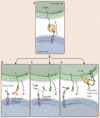Targeting the Siglec-Sialic Acid Immune Axis in Cancer: Current and Future Approaches
- PMID: 36264237
- PMCID: PMC9716255
- DOI: 10.1158/2326-6066.CIR-22-0366
Targeting the Siglec-Sialic Acid Immune Axis in Cancer: Current and Future Approaches
Abstract
The sialic acid-binding immunoglobulin-like lectin (Siglec)-sialic acid immune axis is an evolutionarily conserved immunoregulatory pathway that provides a mechanism for establishing self-recognition and combatting invasive pathogens. Perturbations in the pathway lead to many immune dysregulated diseases, including autoimmunity, neurodegeneration, allergic conditions, and cancer. The purpose of this review is to provide a brief overview of the relationship between Siglecs and sialic acid as they relate to human health and disease, to consider current Siglec-based therapeutics, and to discuss new therapeutic approaches targeting the Siglec-sialic acid immune axis, with a focus on cancer.
©2022 The Authors; Published by the American Association for Cancer Research.
Figures




Similar articles
-
Sialic Acid-Siglec Axis in Human Immune Regulation, Involvement in Autoimmunity and Cancer and Potential Therapeutic Treatments.Int J Mol Sci. 2021 May 28;22(11):5774. doi: 10.3390/ijms22115774. Int J Mol Sci. 2021. PMID: 34071314 Free PMC article. Review.
-
Tools to study and target the Siglec-sialic acid axis in cancer.FEBS J. 2021 Nov;288(21):6206-6225. doi: 10.1111/febs.15647. Epub 2020 Dec 21. FEBS J. 2021. PMID: 33251699 Review.
-
Modulation of Immune Tolerance via Siglec-Sialic Acid Interactions.Front Immunol. 2018 Dec 7;9:2807. doi: 10.3389/fimmu.2018.02807. eCollection 2018. Front Immunol. 2018. PMID: 30581432 Free PMC article. Review.
-
Siglecs in Brain Function and Neurological Disorders.Cells. 2019 Sep 22;8(10):1125. doi: 10.3390/cells8101125. Cells. 2019. PMID: 31546700 Free PMC article. Review.
-
Siglec and anti-Siglec therapies.Curr Opin Chem Biol. 2021 Jun;62:34-42. doi: 10.1016/j.cbpa.2021.01.001. Epub 2021 Feb 16. Curr Opin Chem Biol. 2021. PMID: 33607404 Review.
Cited by
-
Glycosylation in the tumor immune response: the bitter side of sweetness.Acta Biochim Biophys Sin (Shanghai). 2024 Jun 28;56(8):1184-1198. doi: 10.3724/abbs.2024107. Acta Biochim Biophys Sin (Shanghai). 2024. PMID: 38946426 Free PMC article. Review.
-
Decoding CD24: Roles of chemoradiotherapy resistance and potential as therapeutic targets.Oncol Res. 2025 May 29;33(6):1347-1361. doi: 10.32604/or.2025.059327. eCollection 2025. Oncol Res. 2025. PMID: 40486886 Free PMC article. Review.
-
Differential Expression of Immune Checkpoints TIM-3, LAG-3, TIGIT, and Siglec-7 on Circulating Natural Killer Cells - Insights from Healthy Donors Compared to Gastric Cancer Patients.Oncol Res Treat. 2025 Apr 3:1-16. doi: 10.1159/000545429. Online ahead of print. Oncol Res Treat. 2025. PMID: 40179832 Free PMC article.
-
Human-specific elimination of epithelial Siglec-XII suppresses the risk of inflammation-driven colorectal cancers.JCI Insight. 2024 Jul 11;9(16):e181539. doi: 10.1172/jci.insight.181539. JCI Insight. 2024. PMID: 38990656 Free PMC article.
-
Glycosylation Targeting: A Paradigm Shift in Cancer Immunotherapy.Int J Biol Sci. 2024 Apr 22;20(7):2607-2621. doi: 10.7150/ijbs.93806. eCollection 2024. Int J Biol Sci. 2024. PMID: 38725856 Free PMC article. Review.
References
-
- Bornhofft KF, Goldammer T, Rebl A, Galuska SP. Siglecs: a journey through the evolution of sialic acid-binding immunoglobulin-type lectins. Dev Comp Immunol 2018;86:219–31. - PubMed
-
- Leung SO, Goldenberg DM, Dion AS, Pellegrini MC, Shevitz J, Shih LB, et al. . Construction and characterization of a humanized, internalizing, B-cell (CD22)-specific, leukemia/lymphoma antibody, LL2. Mol Immunol 1995;32:1413–27. - PubMed
Publication types
MeSH terms
Substances
LinkOut - more resources
Full Text Sources
Medical

